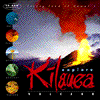
|
| main
| kilauea
| order
| win tec
| mac tec
| staff | |
 |
ecology section |
Explore
Kilauea Volcano explore explore eruption eruption geology geology ecology ecology culture culture
|
 HighlightsEcology of Hawai`iThe Origin of Life A current scientific theory estimates that life first appeared on Earth about four billion years ago. The atmosphere at that time was composed primarily of water, carbon monoxide, carbon dioxide, nitrogen and other gases erupted from volcanoes. There was no oxygen in the environment when life first originated. The actions of living organisms introduced oxygen into the environment. A protective ozone layer was built by this production of oxygen, allowing organisms to live in shallower waters. Eventually, organisms that could breathe oxygen evolved. Evolution of Living Organisms There is evidence that multicellular life existed one billion years ago. Complex animals like jellyfish, worms and mollusks had evolved by 700 Ma (million years). In 570 Ma, organisms developed hard parts that allowed them to be preserved as fossils. Fish appeared in 510 Ma and by 400 Ma, land plants had developed. Around 360 Ma, there was dense vegetation. During this period, amphibians emerged from the sea. By 200 Ma, reptiles and the first mammals had evolved. Arrival of Life Insects, seeds and spiders also reached the islands by riding the air currents or carried by migrating and storm driven birds, either in their digestive tracts or stuck to their bodies. Ocean currents transported salt resistant seeds and rafted insects, plants and snails on floating debris. Amphibians, reptiles, freshwater fish, and most mammals were unable to cross the ocean - only the monk seal and hoary bat succeeded. Of the millions of organisms that embarked on this voyage, very few arrived, and even fewer survived. Over the past 70 million years, plants and animals colonized Hawai`i at the rate of roughly one every 70,000 years. These species evolved over time into new forms and became better adapted to island life. In the absence of predators and competitors their survival no longer depended on elaborate defense mechanisms. These defensive qualities proved unnecessary and were eventually lost. Contradictory terms describe these new life forms: nettleless nettles, stinkless stink bugs, and flightless birds. Text courtesy NPS. Species Introduction: Endemic - Indigenous - Alien The term Native refers to a plant or animal whose ancestors reached the island by natural means. Native species can be thought of in two groups, endemic and indigenous. Endemic plants refer to those species that are found only in Hawaii. Indigenous plants are native to a larger geographic area, found in Hawai`i and elsewhere in the world. Alien plants are those that reached a given geographic area only with the assistance of man. Over 90 percent of the native flora and fauna of Hawai`i is endemic ‚ found nowhere else on earth. The island's 100 endemic land birds evolved from as few as 20 original ancestors; 1000 kinds of flowering plants evolved from 272 colonizers; over 1000 mollusks evolved from at least 22 immigrants; and about 10,000 insects and spider species evolved from 350 to 400 precursors. The astounding diversity of life that flourished on these isolated, once barren islands bears witness to the force of evolution and the tenacity of life. Climate of Hawai`i A major factor in the shape and size of the Hawaiian Islands is rainfall. Rainfall in the islands ranges from more than 400 inches per year to less than 10 inches. This extreme range is the result of wind patterns and mountains on each island. The trade winds blow across the islands from the northeast, bringing moist air that produces rain on the windward side. As an air mass passes to the leeward side of an island, it loses most of its moisture, resulting in less rain. Thick soils, numerous streams, and lush vegetation develop on the windward side. Vegetation Zones of Kilauea Kilauea has several generalized vegetation zones with distinctive plant communities. These include the following characteristic plants: 1. Lowland shrubs: pili grass 2. Lantana - koa haole, natal redtop 3. Open guava forest with shrubs 4. Mixed open forest: `ohi`a, koa 5. Closed guava forest with shrubs: uluhe 6. Closed rainforest `ohi`a, hapu`u pulu, `olapa 7. Open koa forest: `ohi`a 8. Open koa forest: mamane, pukiawe, `a`ali`i Source: After J.C. Ripperton and E.Y. Hosaka (1942), C.H. Lamoureaux (1982) Note: Recent ecological studies have defined dozens of specific vegetation types. Pioneer Plant Life It is a wonder to see how life returns to lava flows. Seeds blown in by the wind are deposited in cracks and take root. The spores of ferns and the tiny seeds of the `ohi`a are often the first to gain a foothold in shady damp cracks. The lava is porous and brittle, so roots are able to penetrate the rock easily. These plants, along with other species are the beginning of future forests. On Kilauea, eruptions continue to dramatically change the landscape. Older flows and forests are buried and reburied by lava flows and, occasionally, by explosive debris. In 1790, a series of explosive eruptions at the summit of Kilauea devastated the entire region surrounding the caldera. The luxurious forest that now surrounds it has grown back since that time. ORDER EXPLORE KILAUEA VOLCANO CD-ROM  | top | main | kilauea | order | win tec | mac tec | staff | Copyright © 2003 Fire Work Media, LLC. |